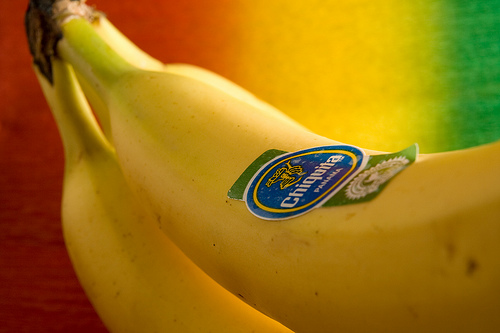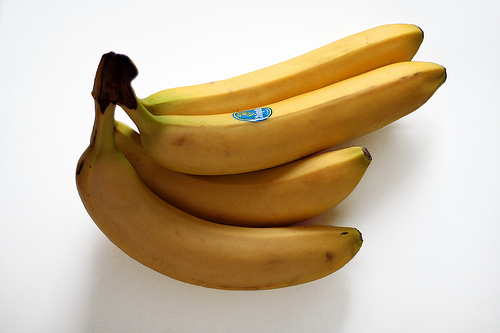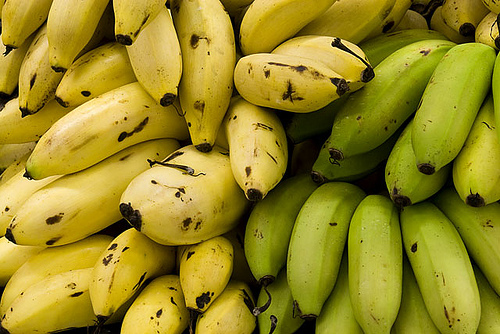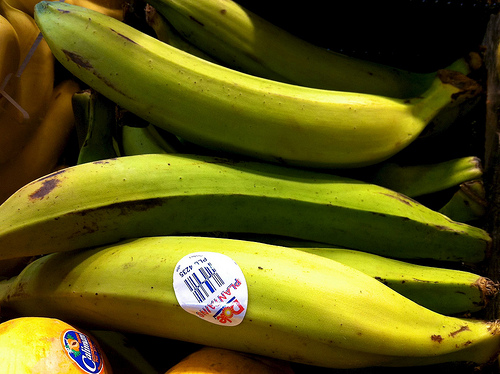
Many people are not aware that there are hundreds of banana varieties in the world. Here in the west, we mainly only see Cavendish bananas. In fact, to most people, a Cavendish banana IS a banana. Imagine a world where you could only buy Red Delicious apples, and no one knew there were other kinds. That's similar to our situation with bananas.
The mighty (yet bland) Cavendish banana
The Cavendish banana isn't even very good, as far as bananas go. It's popular because it is attractive, uniform in size and shape, and ships well. As is often the case with our industrialized system of agriculture, taste does not factor into the equation.
However, the Cavendish banana is under threat, and may not be with us for very long. There is a fungus which could easily wipe out all of the Cavendish bananas, leaving us scrambling to find new varieties.
Frankly, I think this would be a good thing. I would love to see a much broader variety of bananas in the grocery store.

Image courtesy Flickr/24oranges.nl
Gros Michel: a banana lost to the world
This type of banana apocalypse has happened before. Up until the 1960s, the banana most Americans ate was the Gros Michel variety. Have you ever wondered why "banana flavored" things taste so weird? It's because artificial banana flavor was developed to mimic the taste of a Gros Michel banana, not a Cavendish. That should give you a feeling for what we lost, when we lost the Gros Michel.
The Gros Michel was wiped out by a fungal disease that destroyed all of the world's Gros Michel bananas between 1908 and 1960.

Image courtesy Flickr/Fernando Stankuns
Banana magic
Ethylene gas is a chemical which triggers most fruits to start ripening. Bananas happen to give off quite a lot of ethylene gas. You can use this to your advantage, and plan accordingly.
If you don't want your bananas to ripen too fast, be sure to set them out in the open somewhere that the ethylene gas will dissipate. (I have also read that if you wrap the stems in plastic wrap, it will keep them from ripening. But I haven't tested this myself, so I don't know if it is true.)
On the other hand, if you want your bananas to ripen quickly, or if you have other fruit that you want to ripen, just put them into a brown paper bag and loosely fold down the top. I have seen just one ripe banana in a sack full of avocados ripen the whole lot of them within 12-24 hours.
Bananas and latex
Weirdly, bananas contain a chemical which is similar to latex. If you have a latex allergy, you should avoid bananas (as well as avocados and chestnuts) because they may trigger an allergic reaction.

Image courtesy Flickr/CharlesFred
Bananas: Not so great with the potassium, actually
Nutritionally speaking, bananas are basically the junk food of the produce aisle. They are high in starches and sugars, and relatively low in vitamins and minerals. Bananas get a lot of good press about their potassium content, but many more foods (including white beans, spinach, and salmon) are higher in potassium while not being so heavy on the carbs.
On the up side, bananas are highly palatable, especially for kids. And they are wonderfully portable, being easy to grab and eat on the go or at work. (Just be thoughtful to your office mates and go throw the banana peel away in the trash can in the kitchen. Nothing is worse than the smell of a banana skin going bad in your coworker's cubicle.)

Image courtesy Flickr/Farmanac
Plantains: A cooking banana
Technically speaking the Cavendish is what's known as a "dessert banana," one which is meant to be eaten out of hand.
Some grocery stores (particularly those with a broader range of international offerings) also carry plantains. The plantain is not a specific variety of banana, but a type: it's meant to be cooked. Plantains are hard and starchy, so that they hold up well to cooking. In many parts of the world, the plantain is an important food source, not least because it produces fruit all year round.
Plantains can be steamed, boiled, grilled, baked, or fried. In America, plantains are usually served either grilled or fried, and often as a dessert (just to add more confusion to the terminology).
Plantains will turn golden brown when fried, without needing any extra batter. Here's a great recipe for fried plantains dredged in cinnamon, vanilla, and brown sugar. Delicious!
This blog article has three other recipes for plantains, all of them simple and easy: fried and served over rice, baked as a dessert, and steamed on the grill.
Main image courtesy Flickr/pykmi

0 comments